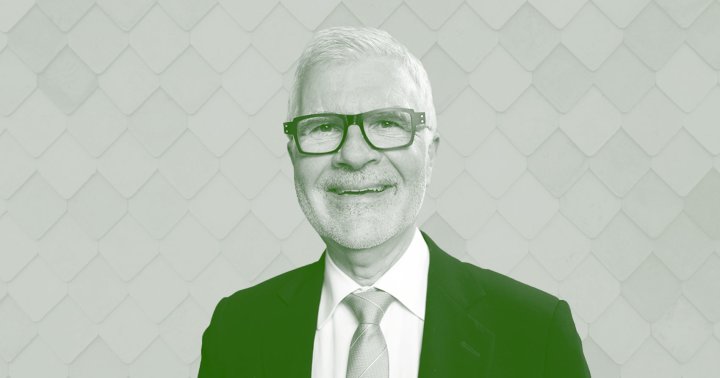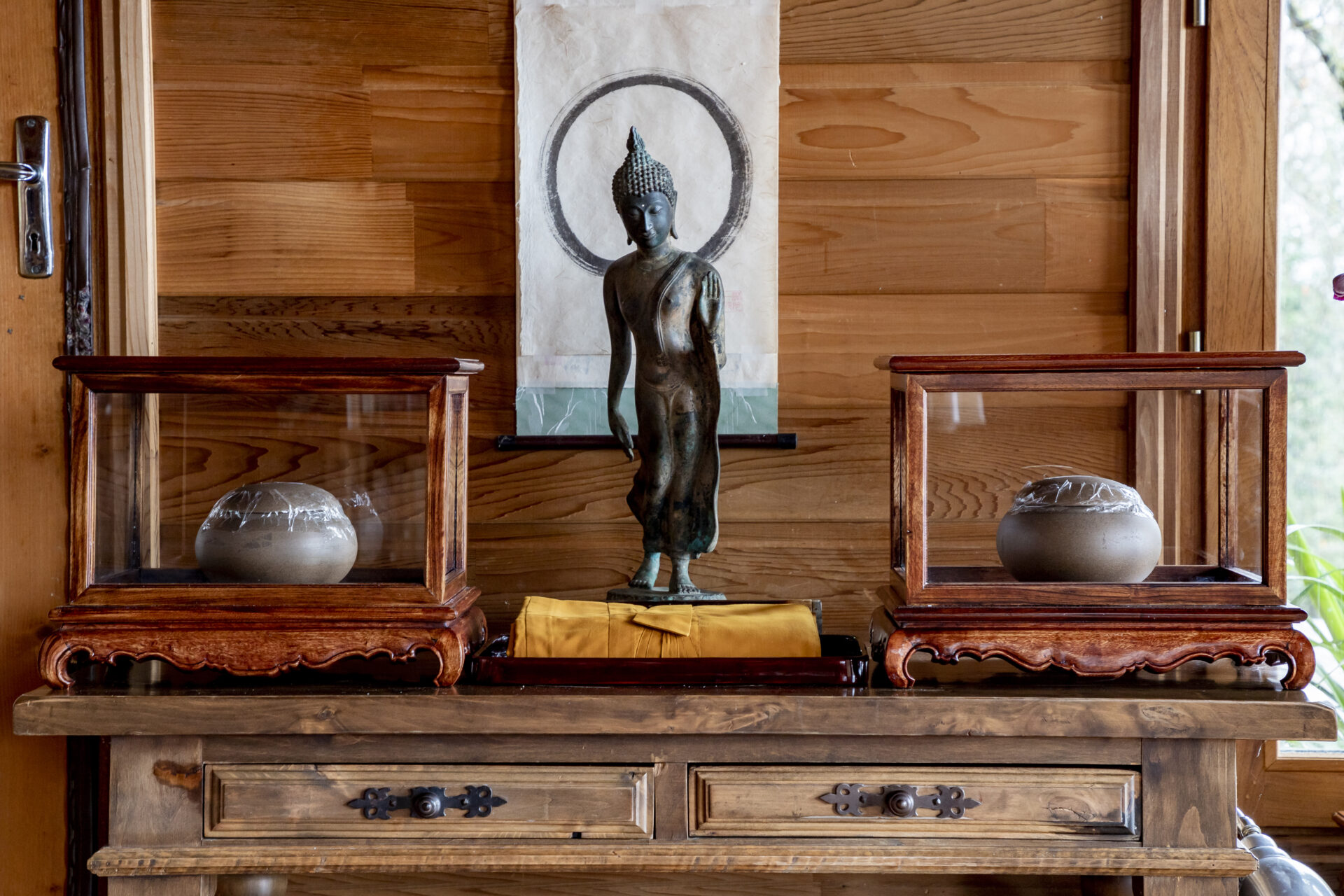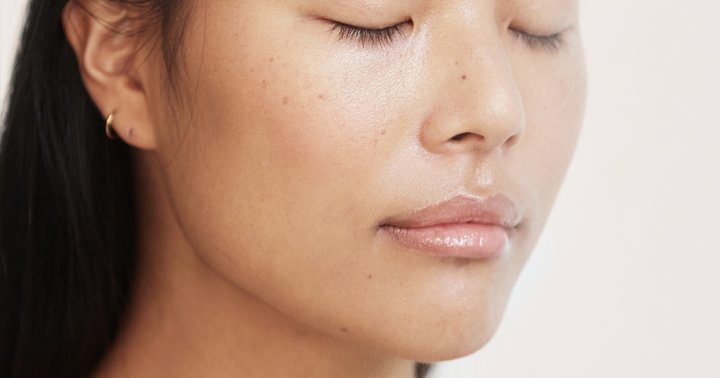Dakini Energy: Feminist-Buddhist Artist Michela Martello
Jennifer Keishin Armstrong profiles the inspiring feminist-Buddhist artist Michela Martello—her life, her work, and the dream that put her on the spiritual path. The post Dakini Energy: Feminist-Buddhist Artist Michela Martello appeared first on Lions Roar.

Jennifer Keishin Armstrong profiles the inspiring feminist-Buddhist artist Michela Martello—her life, her work, and the dream that put her on the spiritual path.

Photo by A. Jesse Jiryu Davis
Michela Martello’s bright green house announces its presence among the staid brownstones of the Bedford-Stuyvesant neighborhood of Brooklyn. It announces that an artist lives here. She answers the door a little breathlessly; calls out to her husband, Mauro Bareti, that guests have arrived, then whisks you downstairs to her domain, her joyful kingdom of art.
Martello’s studio on the ground floor is lined with her brightly colored art and stacks of books about art and Buddhism. The works themselves are so entrancing that you can stare at them contently for thirty seconds or more before you realize you’re looking at, say, a topless woman with clouds coming out of her armpits or a couple of mystical beings having sex. The studio decor contains its own pops of color: a green throw pillow here, a pink door there. You have to duck around a giant, sculptural white dress made of paper that she’s working on for an upcoming installation. She seems remarkably unconcerned when you accidentally brush up against it.
There’s no division between my art and the symbolism of the dakini presence in Buddhism.
Martello, fifty-seven, is a contemporary visual and sculptural artist whose work is full of unique symbolism drawn from her unlikely combination of experiences and influences. There’s her Italian upbringing; there’s the Buddhism she eventually found after a journey that began with a vivid dream; there’s the deep feminist streak she didn’t feel comfortable expressing until she moved to New York City, escaping the conservative attitudes of her home country.
Martello’s work includes not only paintings, but other media, such as murals, ceramics, and other types of 3-D art. One of her ceramic pieces looks at first like a figurine someone might give a young girl as a gift, a princess-like doll in a billowing gown. But there’s a hole where her womb would be, and on her dress it says “I’m not sure I want to have children in this life.” Another ceramic figurine depicts Little Red Riding Hood with images of the Big Bad Wolf on her protective cape. On the cape are scratched the words, “I ate it.”
Many of Martello’s murals feature stippled, textured depictions of women and goddesses, sometimes in the throes of passion with lovers, in soft colors with a distinctive and powerful feminine energy. Other pieces repurpose quilts, army tents, fabrics, animal skulls, and human hair. All of her works deftly combine influences as disparate as the Italian masters, Shakespeare, David Foster Wallace, and Tibetan Buddhism, almost always centering the female experience.

“Future is Goddess,” 2016, 33 x 12 inches; acrylic and lace on vintage linen. Michela Martello has reimagined Botticelli’s Venus as a contemporary goddess whose womb holds a snow lion. This mythical animal from the Tibetan tradition symbolizes strength, fearlessness, and joy.
Martello’s piece Future Is Goddess, for example, riffs on Botticelli’s The Birth of Venus, making the famous figure into a blue dakini with a Tibetan snow lion in her womb. The piece is painted on Italian linen, with a mask of antique lace over the goddess’ eyes.
“I definitely felt this dakini connection very strongly,” Martello says, referring to the tantric female deities found in both Buddhism and Hinduism. “There’s no division between my art and the symbolism of the dakini presence in Buddhism. The Virgin Mary, I didn’t connect with her, but the dakini energy allows me to really go beyond my limits, to break through, without the barrage of judgment or guilt we have in Italy. The culture of Tibetan Buddhism uses that kind of female energy very differently from my upbringing. That’s alluring to me.”
She explains in one of her artist statements: “Learning Buddhist teachings made symbols more apparent. They form a mysterious and refined language at times deep, at times on the surface, until suddenly their story appears from the unconscious.”
Martello grew up in Milan with an unusual father for that time and place. He was constantly doing yoga and was 100 percent opposed not just to Catholicism but to Christianity in general. He would practice yoga completely naked in their house, on a beautiful Indian carpet. He was a pilot, and he’d bring back ideas, particularly from Asian countries, that were a little out there for the conservative, Virgin Mary-worshipping, things-should-be-a-certain-way Italian culture in the 1970s.
That openness likely allowed Martello to be more receptive to a dream she had in 1980 when she was fifteen years old. The dream placed her in Lhasa, Tibet, bringing breakfast to the Dalai Lama—croissants and tea, served on silver. They were in the famed Potala Palace that dominates Lhasa, an arresting structure built into the side of a mountain, with flat roofs on the lower levels and golden canopies on the top. It was unlike anything she’d seen in her young life in Italy.
“It felt like being on another planet,” Martello recalls. She wasn’t sure why this vision came to her—she’d never been to Tibet, and only understood the dream later when she saw photos of the Potala—but she knew it was beautiful, and it stayed with her.
Another dream she had was to live in New York City. She remembers “literally crying when I was very little, saying I wanted to go to New York.” She also knew she wanted to be an artist—she told her kindergarten teacher that she wanted to be “a paintress” when she grew up. She always felt “a little bit out of place” in Italy because of this intense desire to express herself when so many around her were conforming to traditional expectations. To her, the big American city offered the promise of a future free of such constraints.

“Love,” 2010, 70 x 55 inches ; acrylic and pencil on canvas. On her first trip to India, Martello saw many images of cows and contemplated life, death, and transformation. This inspired her to create “Love.”
As she grew up, Martello remained singularly focused on her “paintress” dreams, not on the traditional life of job, marriage, and children. She always felt like a feminist, though it was more of an identity than a political idea for her. “In Italy, I was told many times that I was crazy or strange,” she says. “I think that my way of being feminist was supernatural, like a woman who feels free.”
Its Catholic conservatism aside, Martello is happy to have grown up in a country where she could be influenced by the deep historical art tradition. She was particularly influenced by artists like Giotto, the naturalistic painter of the late Middle Ages whose work is seen as a transition to the Renaissance. “I consider myself lucky because of these beautiful influences, and the beauty of Italy,” Martello says. “But,” she adds, “I always wanted to run away.”
After three years studying illustration at the Europe Institute of Design, Martello went to New York for the first time in 1986, when she was twenty-one. She got mugged for four hundred dollars, which was a lot of money for her at the time, yet that didn’t deter her. She lived on the Upper East Side and had a lot of fun, though she wasn’t making much art, she acknowledges.
“I kept saying, ‘I know I’m an artist. I know I will be a paintress tomorrow.’” In the meantime, she loved her job as a waitress. Even that was something that would be frowned upon in Italy—“That’s, like, very low,” she says, “but for me it was fantastic.”
Martello worked as a waitress for about a year before she began doing illustrations for an English publisher that would send her work. Then friends, and friends of friends, began asking her to paint portraits, which moved her toward larger canvasses. She gave up her waitressing, but reluctantly. “Sometimes I still dream about it,” she says with a laugh. “There was no pressure. There was no responsibility. You have cash in your pocket.”
When Martello first met her future husband, Mauro Bareti, he was opening an Italian trattoria in the West Village. He sold that and now runs another restaurant in the neighborhood. But when they met, he was married and she was living with a man. Their love story would have to wait.

“Lies,” 2015, 18 x 8 inches; pigments and fabric collage on pages from a vintage book. Martello says the dogs in this piece represent loyalty as the antidote to lies.
Martello traveled back and forth from New York to Italy for a stretch, happy with her New York experience but still searching. In Italy, she found Buddhism.
From time to time, Martello struggled with anxiety and panic attacks. She started going to psychotherapy, but found it ineffective. She began to explore holistic and energetic alternatives, though they were difficult to find in Italy in the 1980s. Though she was frustrated, she was also very good at sensing what worked for her: “This for me is always very precise, I know if something fits or not.”
Things began to fit when Martello picked up some books on Buddhism. The ones that spoke to her the most favored the Vajrayana tradition of Tibet—perhaps not surprisingly, given her formative Tibetan dream. She also found a new form of therapy called psychosynthesis, billed as the opposite of psychotherapy. It considered soul and spirit in addition to emotions. She describes it as “working through visualization with symbols and deep relaxation, really working with your body and your imagination instead of just with your intellect.” This shared some elements with Tibetan Buddhism, and she began having new versions of the dream she’d had when she was fifteen.
Martello’s therapist was a student of Namkhai Norbu Rinpoche, a Tibetan Buddhist master of the Dzogchen school and a professor of Tibetan and Mongolian language at Naples Eastern University, and he introduced her to his teacher. When she and the therapist began a personal relationship, they went on a vacation to Tuscany together, where they saw a Tibetan Buddhist fresco inside a Buddhist temple there. She started crying as soon as she saw it, overcome with a deep resonance.
The next day, they saw Namkhai Norbu give a teaching on karma. It seemed to all be coming together—her dreams, the fresco, this teaching. “That was it,” she says. “I knew that I’d finally found my root master.”
She settled back in New York for good in 1998, this time bringing her Buddhist practice with her. Things began to fall into place. She saw Bareti again, and they were now both single, though, she says, “It took me three years to conquer him.” They married in 2007 and have been living in Brooklyn for about ten years.

“The Heavenly Princesses and the Bam Ripple,” 2022, 220 x 180 x 190 inches; acrylic, stitching, and ink on interfacing ironing. This was an installation project for Siao-Long Cultural Park in Taiwan. It depicts Guanyin, Green Tara, the Virgin Mary, and the Chinese sea goddess Mazu. Martello hopes it inspires people to discover their own truth.
Martello is now widely recognized as an artist. Her work was selected by New York magazine art critic Jerry Saltz for “New American Paintings: Juried Exhibitions-in-Print” for the February/March 2020 edition; Saltz owns some of her work in his private collection. Frontrunner magazine describes her art this way: “Michela Martello possesses unparalleled fluidity in her creative practice. Ceramic sculptures, paper murals, and large-scale painted murals are among the wide variety of outlets where she communicates an unabashedly feminine (and feminist) dimensional realism. Martello’s work crosses cultural boundaries and uses symbolism to convey a message from the future not only as that which is good, but as ‘goddess.’”
Her solo shows in recent years have included an entire Future Is Goddess exhibit at Pen+Brush in New York City; Metropolitan Buddha in Milan; and a site-specific installation in Asbury Park, New Jersey, called Eternal Swoon, which included that 3-D paper sculpture of a giant, wedding dress. In September, she’ll have a solo show at Tibet House U.S. in New York.
Martello continues to practice Dzogchen with a community in New York, though that has been relegated to Zoom since the pandemic. She practices meditation at home alone every day, or at least every few days. Since the pandemic, she has found herself more drawn to nature as part of her spiritual practice—sometimes sitting outdoors in a park, or in upstate New York, where she and her husband have a vacation home. “I start to feel some frequency vibration,” she says of communing with nature. “These are experiences that transcend religion. Walking in bare feet. Looking at tomatoes.”
At this point Martello doesn’t think much about how her art, Buddhism, and feminism feed off one another—they just do. “All these things are working well together,” she says. “I don’t feel any friction between one aspect or the other. Probably that’s why I never really thought about it, because it comes natural. Actually, the less I think about it, the more they integrate.”

 Fransebas
Fransebas 































